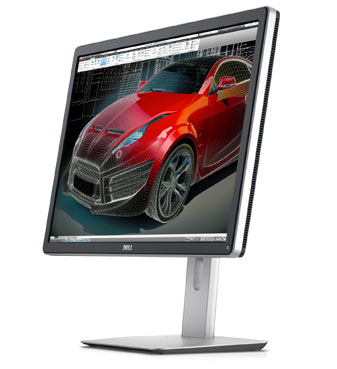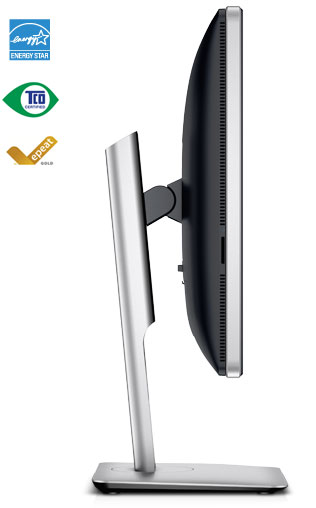Dell Leaks Details of a 24” UHD 4K (3840x2160) Monitor, the UP2414Q
by Ian Cutress on December 1, 2013 12:01 PM EST
Currently there are several 4K options on the market – models using the higher end IGZO displays such as the Dell Ultrasharp 32” 4K (UP3214Q, $3500) or the ASUS PQ321Q ($3500, our review) are currently attracting the most attention. From my perspective (and a few others), 32” is just too large for a desktop monitor and while 4K seems attractive, something smaller (27”) would be more palatable. In comes Dell, who has leaked through their Belize website, the next generation 24” UHD Monitor, the UP2414Q. (Interesting enough it is also mentioned on their US website, through the compatibility list of a sound bar.)

Putting arguments aside about OS scaling and whether someone needs 4K in a 24 inch monitor, the specifications do make for interesting reading:
- 3840 x 2160 in 24 inches = 183.58 pixels per inch, compared to 204 for the IBM T220/T221 and 137.6 for a 32” UHD
- 178º/178º Viewing Angle
- 99% AdobeRGB and 100% sRGB (G-B LED backlight we assume)
- Factory Calibrated to Delta-E < 2
- 10-bit, 1.07 billion colors
- HDMI, DisplayPort, mini-DP, four USB 3.0 and 6-in-1 card reader

Of course, information is limited. Other reports online list this as an IPS panel, although that is ultimately unverifiable at this point in time - we can only speculate that a 24" high end panel is finally making its way through the chain. The 32” UP3214Q from Dell is only 30Hz at full resolution unless you use DisplayPort 1.2a + MST (Chris is testing this monitor as I type), so one might assume that the 24” panel would be the same.
Price and release date not announced – given that the 32” models are around $3500, the offset of a smaller cut of panel against the increased difficulty in creating it might be the competing factors here.
Update: We have some information, direct from Dell's new US website page for the UP2414Q:
Display
Diagonally Viewable Size:
60.47 cm
23.8" (23.8-inch wide viewable image size)
Aspect Ratio:
Widescreen (16:9)
Panel Type, Surface:
In-plane switching, anti glare with hard coat 3H
Optimal resolution:
3840 x 21601 at 60 Hz (DP1.2*)
3840 x 21601 at 30 Hz HDMI
Contrast Ratio:
1000: 1 (typical)
2 Million:1 (Max) (Dynamic Contrast Ratio)
Brightness:
350 cd/m2 (typical)
Response Time:
8 ms (gray to gray)
Viewing Angle:
(178° vertical / 178° horizontal)
Color Support:
Color Gamut (typical): Adobe RGB 99%, sRGB 100%
1.07 Billion colors (8 Bits +AFRC)
Pixel Pitch:
0.137 mm
Pixel Per Inch (PPI):
185
Backlight Technology:
LED
Display Type:
Widescreen Flat Panel Display
Display Screen Coating:
Antiglare with hard-coating 3H
|
Connectivity
1 HDMI connector
1 Mini DisplayPort
1 DisplayPort (version 1.2a)
4 USB 3.0 ports - Downstream (4 at the back, 1 with battery charging)
1 USB 3.0 port - Upstream
1 Media Card Reader
Stand
Height-adjustable stand, tilt, swivel, pivot and built in cable-management
Flat Panel Mount Interface:
VESA (100 mm)
Built-in Devices
USB 3.0 Hi-Speed Hub (with 1 USB upstream port and 4 USB downstream ports)
Size and Weight
Dimensions with stand (H x W x D):
14.61" ~ 19.75" (371.1 mm ~ 501.7 mm) x 22.40" (569.0 mm) x 7.56" (192.0 mm)
Dimensions without stand (H x W x D):
13.33" (338.5 mm) x 22.40" (569.0 mm) x 2.22" (56.3 mm)
Preset Display Area(H X V):
527.04 mm x 296.46 mm
20.7" x 11.7"
Weight (panel only - for VESA mount):
4.8 kg (10.58 lbs)
Weight (with packaging):
10.0 kg (22.05 lbs)
|
Update 2: Pricing has just been announced due to an official Dell press release:
Availability and Pricing
The Dell UltraSharp 32 Ultra HD Monitor (UP3214Q) is available globally starting at $3,499. The Dell UltraSharp 24 Ultra HD Monitor (UP2414Q) is now available in the Americas, starting at $1,399. It will be available worldwide on December 16. The UltraSharp 28 Ultra HD Monitor (P2815Q) will be available in early 2014.
$1400 ?! Can I sign up for a few? That matches the recent batch of IBM T221 models that were sold on ebay this year. For a long while we were expecting some pricing north of $2500, but at $1400 I am actually amazed.










60 Comments
View All Comments
YoshoMasaki - Monday, December 2, 2013 - link
I am on 8.1 with 2 monitors and per-display DPI scaling is working as noted in this blog post: http://blogs.windows.com/windows/b/extremewindows/... Is there something I'm missing here?Penti - Monday, December 2, 2013 - link
Depends on which monitor/res you use as your primary display, the results that is. It's one global setting that will be rescaled not scale independently on the second monitor. If you use 150% on the primary and 200% (or 100%) on the secondary, then the secondary is actually just DWM/bitmap scaling of the 150%. It will not look as good as it should. If you would run the 96 dpi screen as primary then the 100% would be scaled to 200%, thus effectively not utilize the built in scaling.BradMacPro - Sunday, December 1, 2013 - link
Has everybody forgotten that most systems and video cards don't support 4K resolution. A $1700 workstation PCIe card does and the future Mac Pro will support it. And for the matter, I have a Apple 30" and would gladly upgrade to a 32" UHD 4K display except currently it's $3000 for a display and $1700 for a video card. I can juggle the space which also includes a NEC 24" display to even support a 37" UHD display.Sancus - Sunday, December 1, 2013 - link
All modern video cards support 4k resolution, including everything from at least the past two generations of AMD and Nvidia.dragonsqrrl - Sunday, December 1, 2013 - link
You don't need a Quadro or Firepro. Any GTX600 series or later card supports 4K output through displayport, the same goes for HD7000 series or later. Even Intel's integrated graphics has supported 4K output since the HD4000.TinHat - Monday, December 2, 2013 - link
Just cause they can show 4k resolutions doesn't mean they can handle it very well. Only the newer graphic cards have 4k enabled hardware. Bet even PacMan looks slow on software driven cards at 60Hz. Loldragonsqrrl - Monday, December 2, 2013 - link
The first sentence makes it almost sound like you know what you're talking about, even though it has nothing to do with the comment I responded to. It's true that simply because a card supports 4K output doesn't necessarily mean it can run games well at that resolution. In fact you could say the same about any card ever made with respect to the max resolution it supports. Of course this exercise in trivia is completely irrelevant within the context of the comment from BradMacPro, which simply claimed that you needed a Pro workstation card in order to "support" 4K resolutions.But then your next two sentences made me realize that none of that is what you actually meant. In fact I'm not even sure what the hell you're talking about. "software driven cards"? Are you suggesting that previous gen cards didn't support hardware acceleration at 4K resolutions? And that only "newer" 700 series cards support that feature? I think you might have some sort of profound misconception about how this all works, and all I can do is reassure you that this isn't the case. Any card from the last two generations supports 4K output in hardware.
abrowne1993 - Sunday, December 1, 2013 - link
So why is it called a "leak" if it's coming from Dell?IanCutress - Monday, December 2, 2013 - link
It didn't come via PR, and can only be found through their Belize website - not any others. So someone must have hit go on a page that should still be hidden until an announcement.RussianSensation - Monday, December 2, 2013 - link
I've been running a 37 inch 1080P monitor for games and it's been very good, but I'd like to upgrade to a 32-37 inch 4K at some point. $3,500 asking price is just too steep. The Asus and Dell monitors are also ugly and cheaply built for such a high asking price. If you are going to ask that much, it better look sexy such as the Samsung LEDs or flagship Panasonic Plasmas.4K on a 24 inch monitor hardly makes sense as even 2560x1440 is already sufficient. In that case, you are simply wasting GPU horsepower. You need a bigger monitor to really take advantage of the extra details 4K offers.